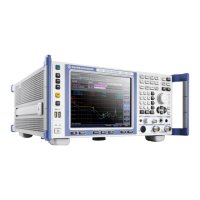Instrument Tour
R&S
®
ESR
22Getting Started 1316.3749.02 ─ 09
MEAS Provides the measurement functions, for example:
●
the bargraph measurement (in Receiver mode)
●
the scan and final measurement (in Receiver mode)
●
the AF demodulation (in Receiver mode)
●
IF analysis (in Receiver mode with option R&S ESR-K56)
●
the realtime spectrum (in Realtime mode)
●
the spectrogram measurement (in Realtime mode)
●
the persistence spectrum (in Realtime mode)
●
the channel power and ACLR measurement (in Spectrum mode)
●
the occupied bandwidth measurement (in Spectrum mode)
●
the Spectrum Emission Mask (SEM) measurement (in spectrum
mode)
●
the spurious emission measurement (in spectrum mode)
●
the signal statistics (in spectrum mode)
MEAS CONFIG Provides functionality to configure the measurement.
LINES Provides functionality to control display and limit lines.
INPUT/OUTPUT Provides functionality to configure inputs and outputs.
RUN SINGLE Starts a single measurement.
RUN CONT Starts a continuous measurement.
UNDO Reverts the last operation.
REDO Repeats previously reverted operation.
4.1.3 USB Interface
The front panel provides two female USB connectors to connect devices like an
external keyboard or mouse. You can also connect a memory stick to save and
restore instrument settings and measurement data.
4.1.4 Noise Source Control
The noise source control female connector is used to provide the supply voltage
for an external noise source, for example to measure the noise figure and gain of
amplifiers and frequency converting DUTs.
Conventional noise sources require a voltage of +28 V in order to be switched on
and 0 V to be switched off. The output supports a maximum load of 100 mA.
The Front Panel

